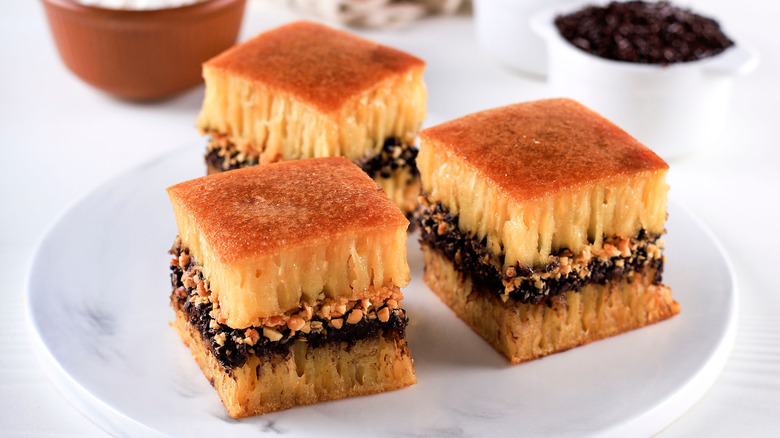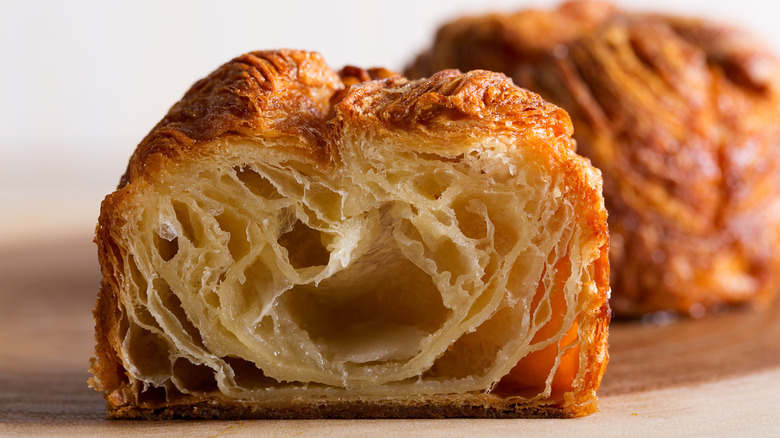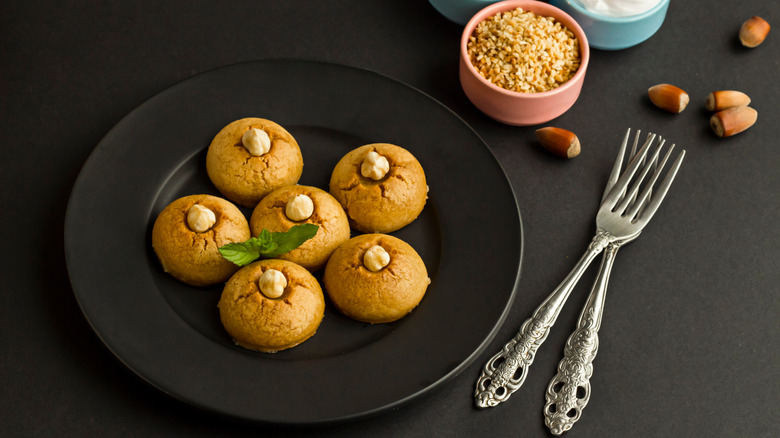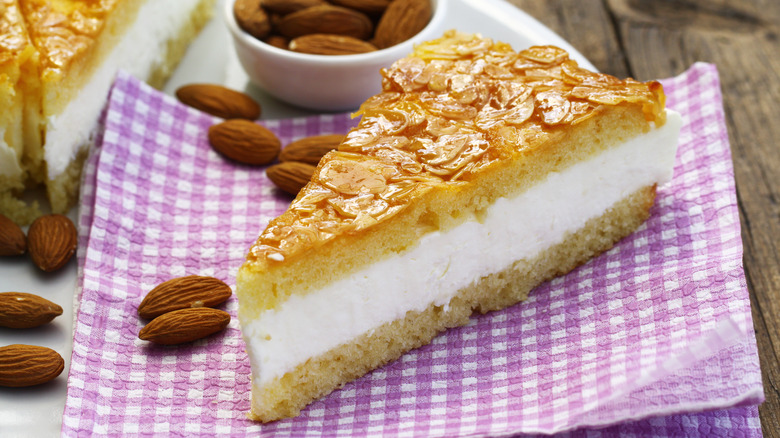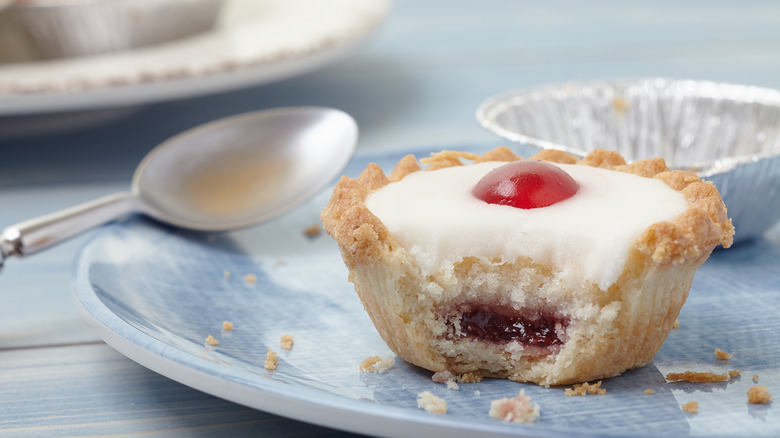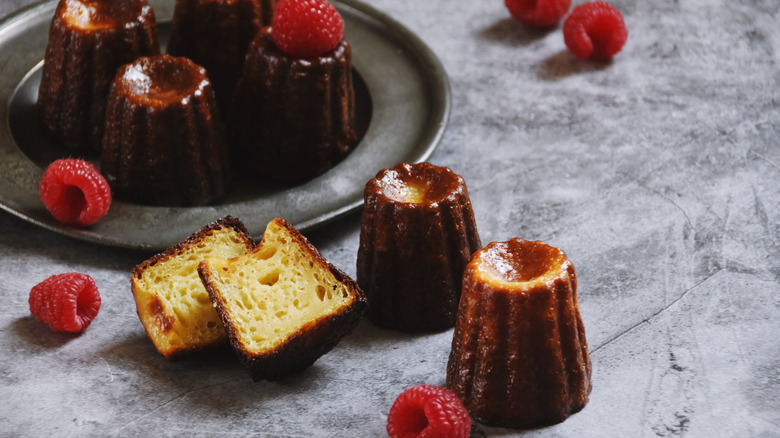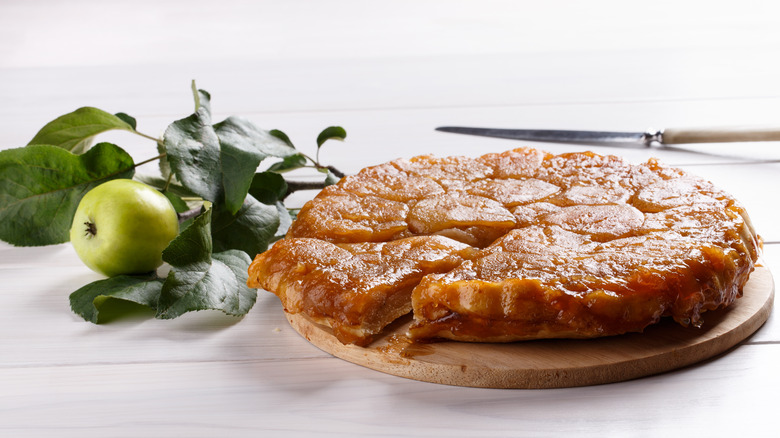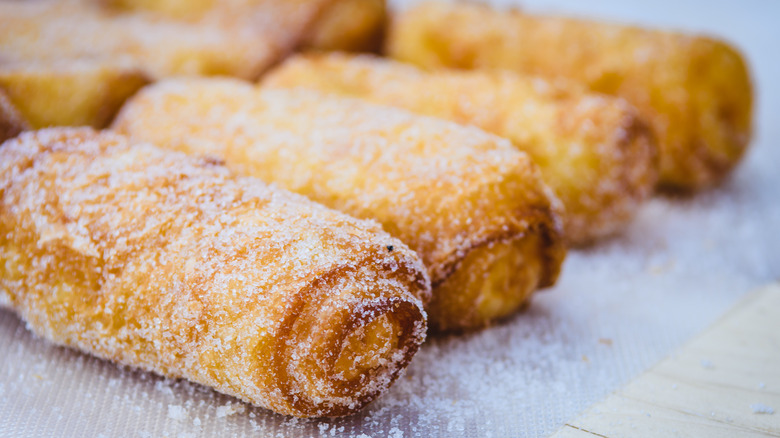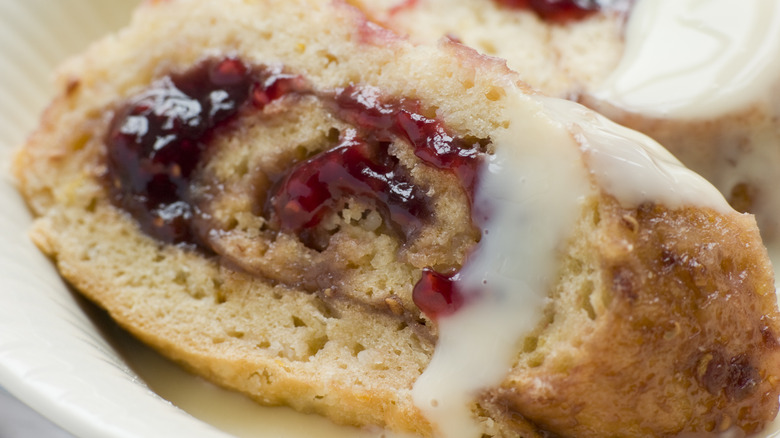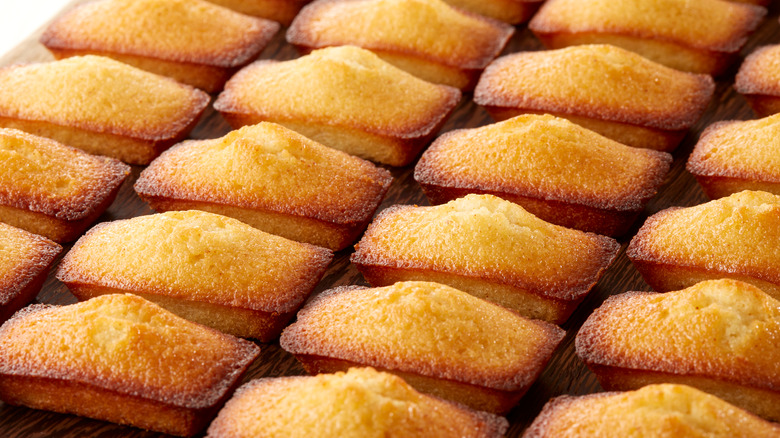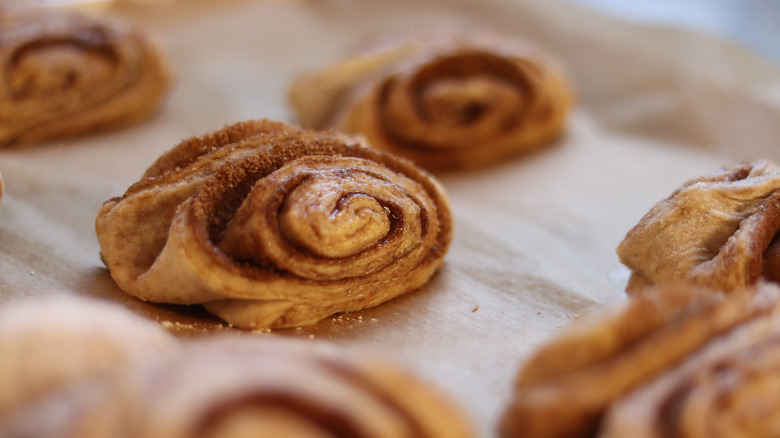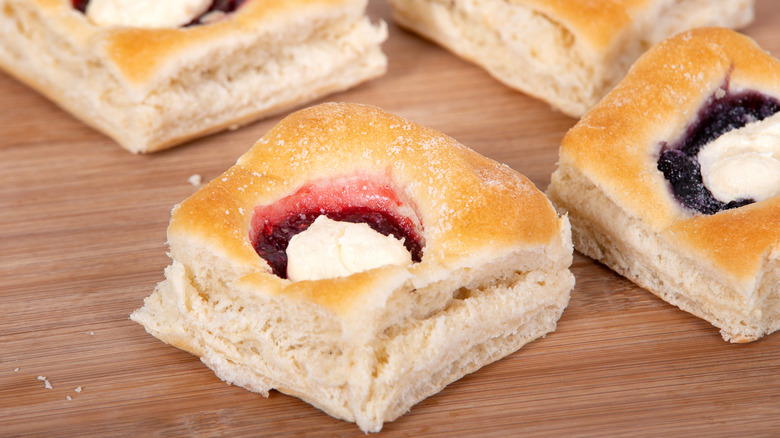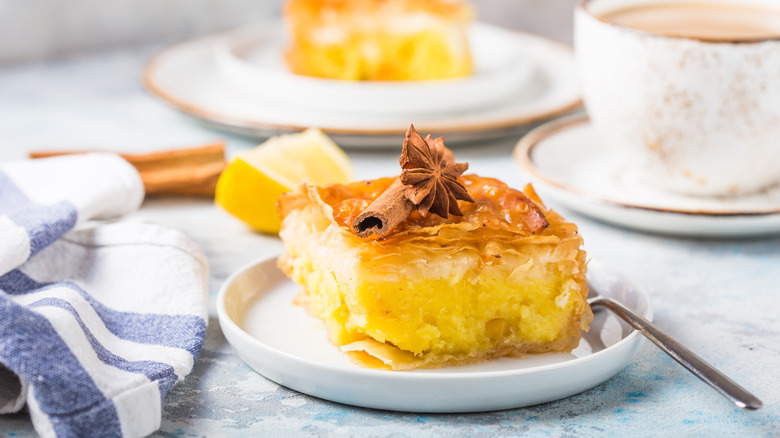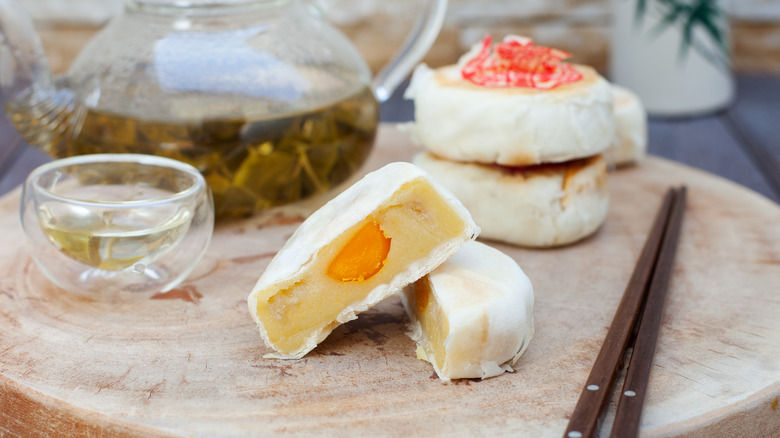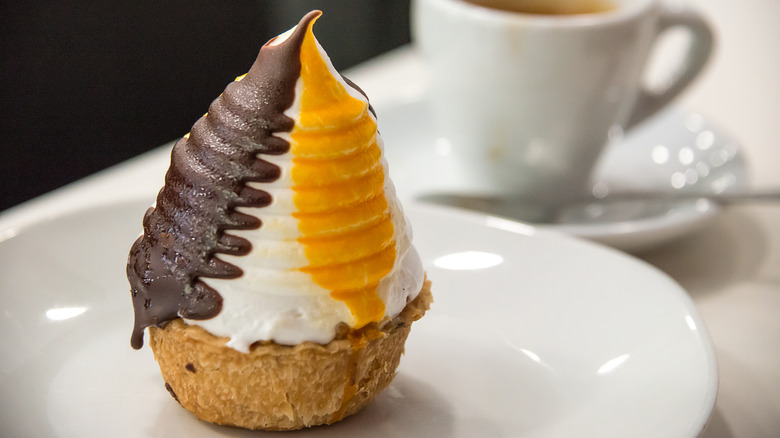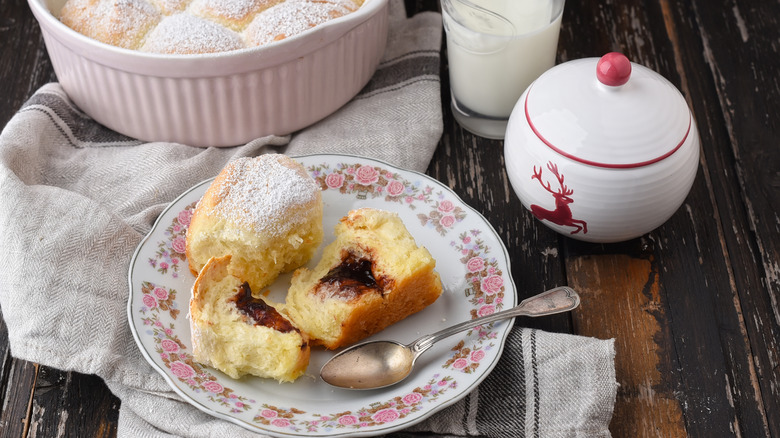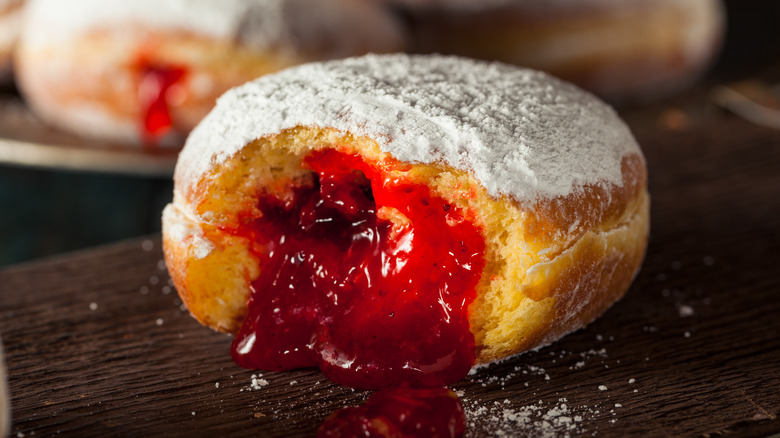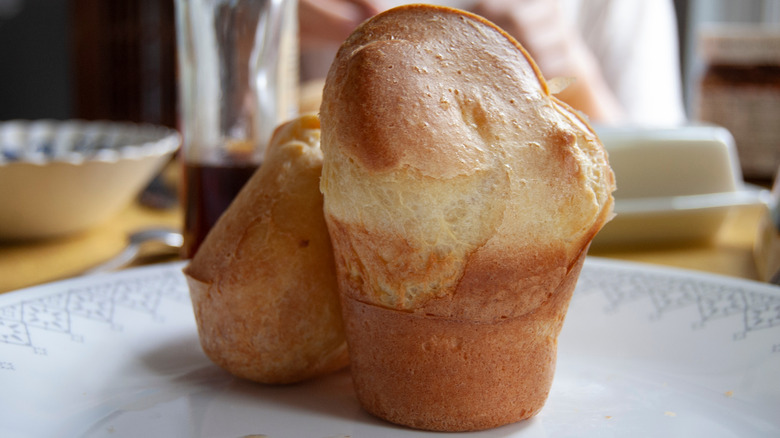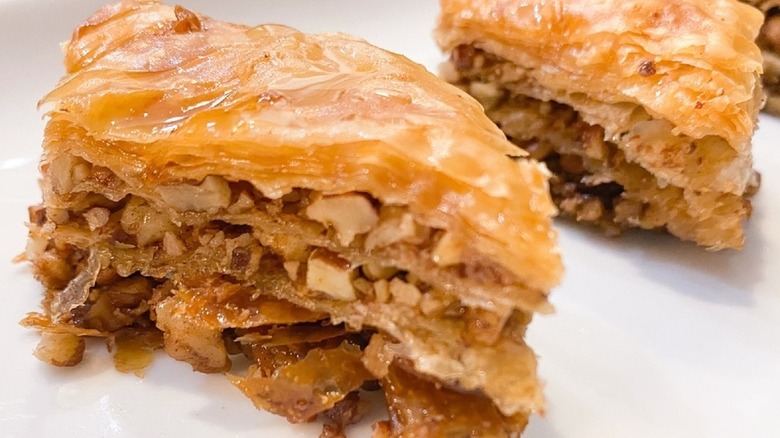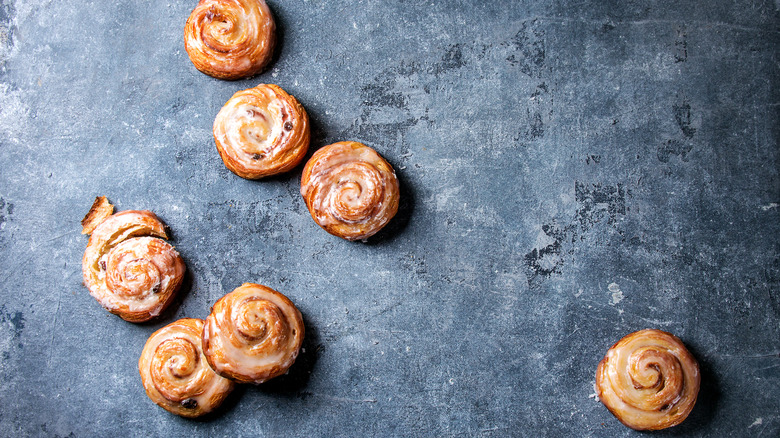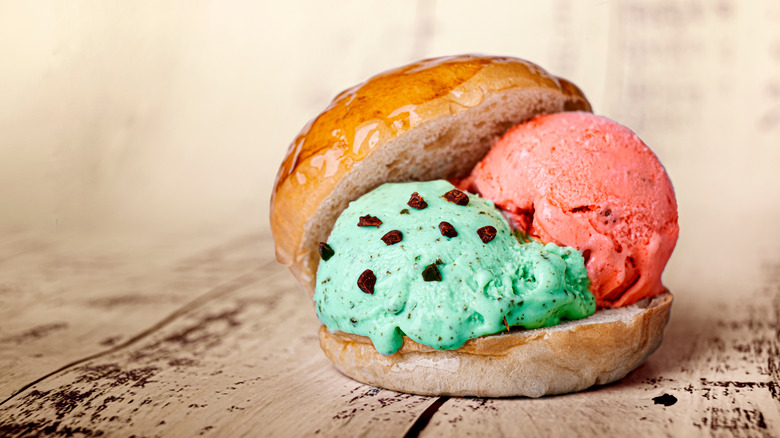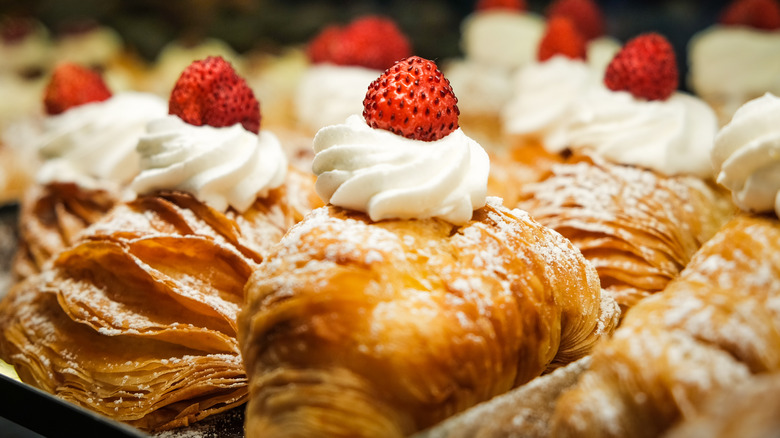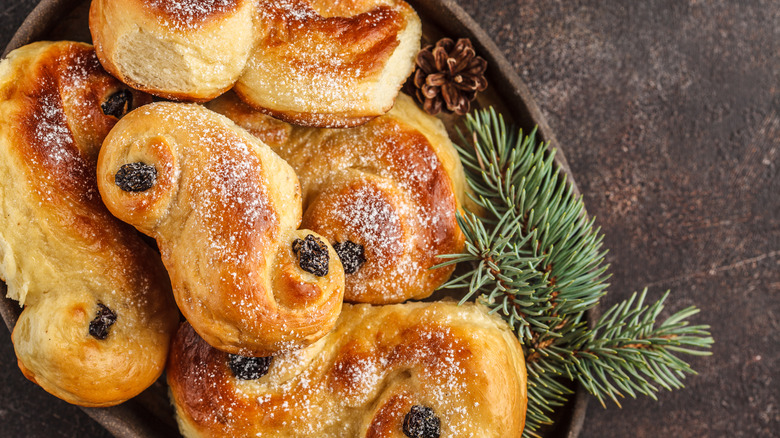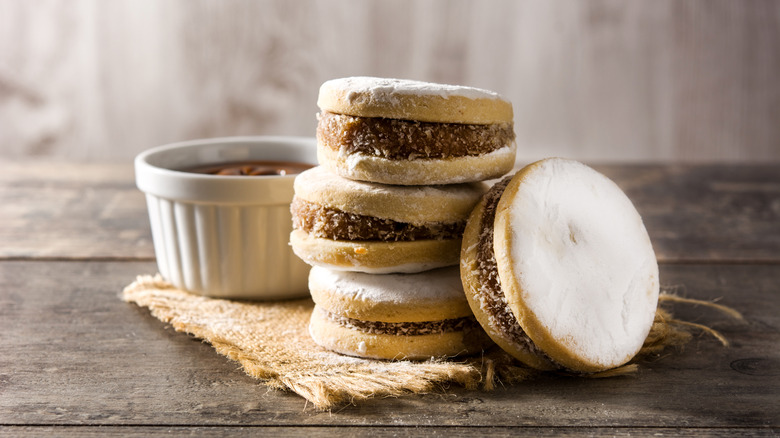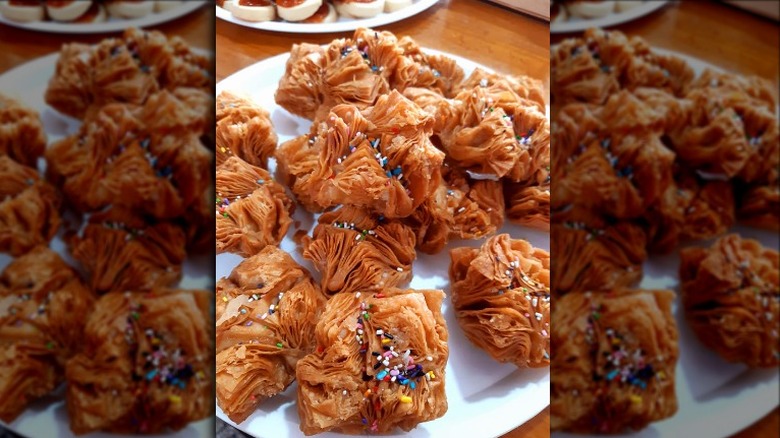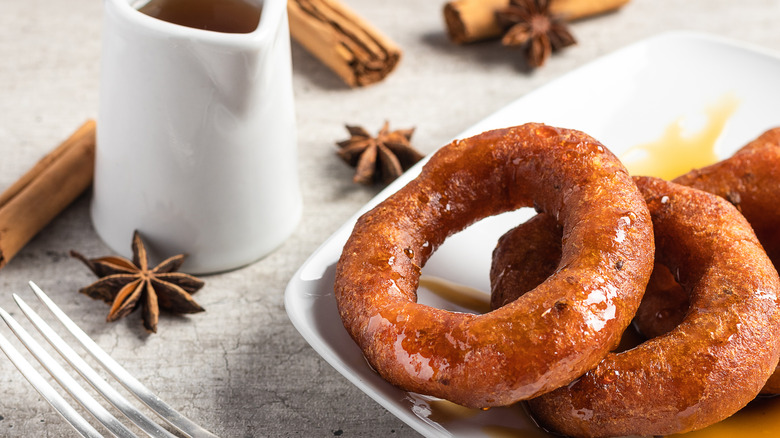The Most Unique Pastries You Need To Try At Least Once
Humans have done a lot of really amazing things in their relatively short time on this planet — feats like building the Great Pyramid of Giza, inventing cars, and sending people rocketing into space, for instance. Long-ago humans also invented pastry, a delicious gift that just keeps on giving today.
Pastries have been around for a long, long time. According to Great British Chefs, it's believed that the ancient Egyptians were amongst the first people to invent pastries. These early pastries were a simple mix of oil and flour, making a basic dough was used to create a variety of cakes, tarts, and dumplings that were so important that they were immortalized in tomb art. The Romans picked up on this love of pastry, too. If you fast forward to the Middle Ages, that's when pastries turned into something similar to what we'd recognize today.
Bottom line? Pastries have been ridiculously popular for generations, and that means it's no surprise that there's a ton of unique pastries found across the globe. Many are rooted in centuries of tradition, some are modern, but all are worth trying at least once.
Martabak
For truly authentic martabak, you'll have to head to Indonesia. SBS calls it "street food's finest," and while you might find these pastries made to be either sweet or savory, you should know they're made in very different ways. While a savory martabak starts with a thin, pan-fried wheat dough — something akin to a quesadilla — the sweet martabak is completely different.
For sweet martabak, the dough and resulting pastry is much thicker than its savory cousin. Imagine a sweet, eggy pancake, baked in a skillet, and topped with fillings like butter, chocolate, peanuts, and sesame seeds. It's then taken off the heat, sliced in half, and sandwiched around the filling. Other versions might use fillings like Nutella or use red velvet flavors in the pancake, but whichever way you slice it, it's downright delectable.
Kouign-amann
French pastries have a reputation as being light and dainty, but the pastry called kouign-amann didn't get the memo. According to Food52, this pastry is believed to have originated in an area of France called Brittany. The name of this heavy, croissant-muffin hybrid simply means "butter cake." It's certainly true to the name, being heavy on the butter, with sweet caramelization and a rustic presentation.
Unlike many pastries, the kouign-amann is made of only a few ingredients, namely butter, sugar, and dough. That means it's of the utmost importance that only high-quality ingredients are used to create delicious pastry. It's so important that Breton bakers have organized into The Kouign-Amann de Douarnenez Association in order to promote their pastry and preserve their heritage with a designation that would forever link it to the area of its origin.
Sekerpare
Sekerpare is a dessert that would have anyone from Turkey nodding knowingly. According to The Spruce Eats, they're a staple pastry that's found in nearly every bakery in the country, and it's no wonder: they're delicious. They're essentially sweet cookies that are baked, but that's not the end of the process. Once they're golden brown, they're left to soak in a lemon syrup — and the longer they're left, the better they are. Unlike the "cookies" that someone from the west might think of, these are soft pastries you can cut and eat with a fork.
Delicious, right? There's one more important component, and that's semolina flour, which is made from durum wheat. According to Bob's Red Mill, semolina has "a more earthy aroma" compared to other variations on wheat flour, making it the perfect thing to balance that lemony sweetness.
Gibassier
When it comes to a proper gibassier, there are just a few things that are included in the mix, but you've got to be specific. Some ingredients, according to Pastries Like A Pro, are occasionally left out of some not-so-authentic versions.
For starters, the shape of this French pastry should be reminiscent of a fleur de lis, a symbol that Perfectly Provence describes as a stylized lily flower long associated with French kings. The pastry is also traditionally flavored with anise. But for those who can't stand anise, there are versions that skip this sometimes polarizing ingredient.
Made from a type of dough that forms a bread reminiscent of brioche, the combination of anise and candied orange peel creates a flavor that's pretty perfect in such a lovely pastry. Want to try the real thing? Head to Provence, France, the origin place of this luxurious sweet treat.
St. Martin's Croissant
November 11 is an important date in Poland, as not only is it the national Independence Day, but it's also St. Martin's Day — and that's where the pastry comes in. According to Atlas Obscura, an estimated 700,000 of these special croissants are made and eaten on this day alone! These flaky pastries have a layer of paste made from nuts (particularly almonds), sugar, butter, and poppy seeds spread between each of the 81 layers.
That's right, 81 layers! According to the legend retold by Taste is Yours, the pastry first appeared at the end of the 19th century. It was created by a baker who, having just listened to a sermon about acts of charity, decided to create a pastry specially made for the less fortunate. The shape was inspired by the story of St. Martin and his horse, who lost a horseshoe as they were riding along, inspiring the pastry's shape.
Bienenstich
Bienenstich translates to "bee sting cake," but this German pastry is much, much more pleasant than that name might suggest. According to one story, it's believed that the name came because of bees who were attracted to the sweet honey glaze, and ended up stinging the baker, according to I Like Germany. There's also another, older tale that says the name came from bakers who drove off threatening invaders by hurling beehives at them. Pretty epic, right?
That story might be of questionable authenticity, but one thing that's not questionable is how delectable this treat is. It's basically a sweet bread with a layer of vanilla filling in the center, which is then is covered with a sweet honey glaze and sliced almonds. Seconds? Yes, please!
Bakewell tart
As fans of The Great British Baking Show may already know, the Bakewell tart comes from the UK. Supposedly, it's named for the Derbyshire town where it was invented but, according to HistoryExtra, the modern pastry that's so popular across England is a far cry from the original pudding that was invented in Bakewell.
Today, Bakewell tarts are basically tiny treats that look like mini pies. They're made with shortcrust pastry, with an almond-flavored layer that covers the bottom, itself topped with another layer of fondant. The whole thing is topped with a glace cherry. The treats are wildly popular, and it's no wonder why. Bakewell tarts as they're served today are soft, nutty, and not overwhelmingly sweet, which makes them pretty much perfect for serving alongside a cup of tea.
Gâteau Basque
The gâteau Basque first made an appearance in French markets in 1830 and, according to Explore France, the treat became so popular that the pastry chef who created it, Marianne Hirigoyen, became known as the awesomely-named Basque Cakewoman. Originally a family recipe passed down through the generations, the gâteau Basque has since spread across the globe. NPR says you don't have to book an international flight to try these tasty pastries, as they're easy enough to find in the United States nowadays.
Not all gâteaus Basque are the same, though. For instance, while some have a layer of pastry cream between the layers of cake, others have a black cherry jam. So, how to know what you're about to bite into? You can tell the difference by looking at the decoration on top. If there's a cross, it's jam, and if it has cross-hatching, it's cream. Neat, right?
Beaver Tails
It's time to head to Canada for the delicacy that is the beaver tail. Yes, they do look very much like the tail of a beaver, but don't fret. Beaver tail pastries are inspired by the old fur trader practice of cooking actual beaver tails over open fires. Fortunately today, no actual beavers are harmed in the making of these pastries.
According to Culture Trip, the beaver tail can be thought of as a Canadian take on the donut. It's a wide, flat piece of hand-stretched dough that's deep-fried and covered with all kinds of sweet goodies that can include things like frosting and candy to cream cheese and everything in between.
Unlike many pastries, beaver tails are a fairly recent invention. They only really came onto the scene in the late 1970s and early 1980s. But, ask anyone who's had one and they'll say these beaver tails are here to stay.
Canelé
According to the Institute of Culinary Education, finding a real, properly authentic canelé in the US is difficult, because they're not only difficult to make, but they're time-consuming and complicated as well. But, they add that these pastries are totally worth the effort.
The history of this French pastry is widely debated, but it's generally agreed that they've been around since some time between the 15th and 18th centuries, when they originated thanks to a very old drive to leave zero waste in the kitchen. Winemakers who used egg whites in the winemaking process would give their extra egg yolks to local convents, who would then use the yolks to bake pastries for the less fortunate. Ultimately, one of those pastries was the canelé, a delicious treat that's traditionally made in copper tins, enhanced with the flavors of rum and vanilla.
Tarte Tatin
The best way to describe the French pastry known as the tarte tatin is with a little imagination. Imagine, if you will, an apple tart. The crust is delicate and flaky, the apples are soft and covered in caramel. Now, imagine if you baked it upside-down. That way, the pastry gets extra crispy and the apples grow extra soft. That, says National Geographic, is the tarte tatin.
The dessert's name comes from the Tatin sisters who are credited with first making it at a hotel nestled in the forests of Sologne, France. While it's generally said to have been created by accident, it has, over the years, been modified in a number of delightful and delicious ways. You might find it made with a different fruit, a dash of brandy, or some extra seasonings, but it's the classic that's a true must-try.
Croquembouche
The croquembouche might be a popular option for a traditional wedding cake in France, but elsewhere, this elegant pastry tower is anything but common. According to The Good Life France, it's essentially a conical structure made of balls of puff pastry that have been filled with cream and then arranged into their distinctive tower shape. The whole affair is then covered with caramelized sugar. Sometimes, the puff pastry is covered with chocolate or icing or decorated with other types of goodies but, regardless of the decoration, the basics remain the same.
The puff pastries of the croquembouche aren't just tasty. The entire thing is proof that, when it comes to the line between art and pastry, that line can be very fine indeed... and it's probably made from spun sugar.
Xuixo
According to Atlas Obscura, the creator of the xuixo wasn't a baker at all, but an acrobat. He became widely known in the Catalonian city of Girona for his performances before plague victims, and along the way, he happened to fall in love with the daughter of a pastry chef. Their secret romance was discovered when the acrobat sneezed while hiding in the bakery. There's a happy ending, though. The acrobat got to marry the girl and gave his new father-in-law a new pastry recipe in thanks. That was the xuixo, named for the sound of that fateful sneeze.
The pastry itself is a delicate, deep-fried pocket of sugar-coated goodness that's also filled with a cream pastry. Better yet, it's also the star of an annual festival called Marxa del Xuixo, an occasion that's used to raise money for Girona's cancer patients.
Jam Roly-Poly
The jam roly-poly very much a product of medieval Europe and, according to The Guardian, it's still pretty basic. Think of it as a rolled dessert (like a Swiss roll), but the "cake" part is actually a steamed suet pudding, while the filling is a jam. The modern version of the pastry was created in the mid-1800s and, when it became popular, it became really, really popular. It even gets a mention in author and illustrator Beatrix Potter's works.
According to British Food, it's also called a dead man's arm, though the name origin probably isn't as bad as you're thinking. As the story goes, in ye olde times, it was common to steam the dessert inside an old shirt sleeve.
Financier
Running a successful business is as much about finding a target market as it is about creating a great product. According to Atlas Obscura, some incredibly enterprising bakers in 19th century France struck, well, gold with their new pastry.
At the time, the Paris stock exchange sat on Rue Saint-Denis. An area pastry chef decided to take a medieval recipe created by the Sisters of the Order of the Visitation and give it a bit of a makeover. The nuns' recipe for little round, nutty cakes were turned into bars — the shape of precious metal ingots — and renamed "financiers" after the investors in the neighborhood.
It wasn't just area bankers who loved the simple, spongy, nutty, golden pastries. All of Paris started clamoring for the treats. Today, some versions of financiers include chocolate in the batter, while others might even come with candied ginger or poached prunes in the mix. That's all wonderful, but it's the original — often served with sorbet — that's still the best for many dessert fanciers.
Franzbrotchen
Imagine a big croissant, filled with either chocolate or cinnamon. Now, give it one good punch, right in the middle. That's a franzbrotchen, and it's entirely possible the punch you just imagined giving a croissant is oddly appropriate for the pastry's history.
Franzbrotchen were first made in Berlin when the city was occupied by Napoleon's troops. Atlas Obscura says that, while there's a version of history that suggests this was as close as German bakers could get to French croissants, it's also been suggested that German bakers absolutely could recreate a croissant perfectly... they just chose not to. Instead, they created their own act of pastry-based rebellion, and so this heavy, cinnamon-flavored roll remains popular to this day.
Kolache
Chances are pretty good that anyone who lives in or has visited Texas is already familiar with the kolache. That's because a swatch of rural Texas was settled by an influx of Eastern European immigrants in the 1880s. When they came, they brought this delicious, sometimes-sweet, sometimes-savory pastry with them.
Kolaches are traditionally Czech pastries, says Texas Monthly. Many of the bakeries that are making them today include a sweet fruit filling (meanwhile, traditionalists say that meat-based fillings are just morally wrong). If you want something super traditional, those are fillings made with ingredients like prune, apricot, and cream cheese. NPR says that as kolaches spread across the US, they changed shape a bit. Today, you might find some that are square and some that are round, but no matter how you shape them, they're just yummy.
Galaktoboureko
Good things come to those who wait. Anyone who's taken a crack at making a traditional galaktoboureko knows that's true, mostly because the crust of this pastry is made from phyllo dough, which can be a bit of a headache to handle on the best of days.
According to 30 Days of Greek Food, the pastry is essentially made by first brushing sheets of phyllo dough with butter, layering them into a pie, then adding a thick layer of custard made from egg, semolina, and sugar, followed by yet more buttery phyllo. The whole thing is then baked, allowing the phyllo to absorb that custard and transform into a truly delectable dessert that people have been enjoying over many centuries, ever since Greece was occupied by the Ottoman Empire.
Banh pia
The Saigoneer describes the banh pia as a Chinese-influenced Vietnamese pastry that's long been linked to worship of the moon during the Mid-Autumn Festival. It's shaped a bit like a hockey puck and made from a crust that's similar to a puff pastry, but is actually made from two very different types of dough arranged in super thin layers.
Cut one of these popular little pastries in half and you'll see a creamy yellow filling that's almost the color of dark lemon curd and looks like it might have the texture of custard. It is, indeed, creamy, but that filling is actually a mixture of caramelized lard, mung bean paste, rice flour, and the famously stinky durian! Sure, durian is notoriously smelly, but some people really enjoy its flavor. Want to try durian? This might just be the way to do it!
Carolinas
The beautiful, delicate pastries known as Carolinas have nothing to do with the north or south or, in fact, the United States at all. Instead, these sweet treats come from Bilbao, Spain. According to the popularly told tale repeated by Bake Street, they were the creation of a baker who wanted to surprise his daughter with something beautiful — and easy to eat — on her birthday. He took a small puff pastry crust, then swirled on a tower of meringue. Not only did she love it, but his customers did, too, so he kept it on the bakery's menu and named it after his daughter, Carolina.
The pastries are still wildly popular, often covered with a chocolate coating, finished with a brush of egg yolk, and various other embellishments like edible gold or sprinkles.
Buchteln
Way back in 1996, Austria celebrated a birthday. They'd officially been calling themselves Austria for an impressive 1,000 years. In honor of the occasion, the Los Angeles Times took a look at one of their most popular pastries, the buchteln.
What's a buchteln? Imagine a brioche roll, but imagine the same flavor and texture, but lighter and less buttery. Today, they're typically served on a plate with cream sauce, and if they're left to soak up the sauce before the lucky diner digs in, then they're even better. Inside is a little center of filling that's most traditionally apricot or even prune, but that's a fairly recent addition to the pastry... in the grand scheme of things, of course. At one time, it was lottery tickets that were baked inside, giving the pastries their old name: "lotteries."
Paczki
At a glance, a pączki looks like a jelly donut, and it sort of is... but to those who still celebrate their Polish heritage, it's so much more. This special treat derives its name from the Polish word for a flower bud, pączek – a particularly fitting name given the time of year they're often consumed.
In Detroit and other cities with large Polish communities, pączki generally show up around the beginning of Lent. That's because families have traditionally made batches of paczkis as a way to use up supplies like butter that wouldn't get used during the spartan times of fasting that make up the 40 days of Lent. Just like New Orleans has Mardi Gras, then, Polish communities have Paczki Day. These soft, brioche-like donuts are fried up and dusted with sugar by the dozen, filled with all kinds of jams, jellies, and creams.
Jordan Pond Popovers
Popovers have been a staple of New England cuisine for a long time, at least since the 19th century, says Atlas Obscura. That's when settlers from Europe brought along the idea of a Yorkshire pudding and made it into something completely different and still wonderful.
So, what exactly are popovers, and what does Jordan Pond have to do with it? As for the pastry, Downeast describes them as light, eggy, custardy rolls that are more air than pastry. They rise a little like a soufflé — and they're just as difficult to master — but it's McIntire's tea house that's perfected them. The tea house first opened its doors in 1895. The rebuilt inn (the first burned down in 1979) still sits on the shores of Jordan Pond in Maine and serves around 2,500 of these popular pastries, along with butter and strawberry jam, each and every day during tourist season.
Baklava
When it comes to the granddaddy of all pastries, baklava is a legitimate contender. There are numerous countries that claim this delicious dessert as their own, and they've been laying claim to it for around 3,000 years.
Yep, we said 3,000 years. Historians have traced the history of baklava all the way back to the Assyrian Empire, according to Great British Chefs. The version we know today isn't quite that old, but it still goes back a respectable amount, all the way to the Ottoman Empire and the 17th century. Our modern version is essentially phyllo dough layered with butter, a mix of nuts, and cinnamon, then covered in a sweet honey syrup. Sounds amazing, right? It is, and there's a bonus: Mashed has a recipe that's surprisingly easy to make, so you can try this one right in the comfort of your own home.
Southern butter rolls
Cinnamon rolls are wildly popular, and there's a good reason for that. Anyone who makes a beeline for Cinnabon but has never tried the glorious creations that are southern butter rolls definitely needs to add these to their bucket list.
So, what are they? According to Kitchn, southern butter rolls seem to have originated in the Mississippi Delta. They're a variation of cinnamon rolls in that they're made with biscuit dough and rolled with a familiar mixture of cinnamon, sugar, and other spices, but that's where the similarity ends. They're then covered in a custard mixture and baked into a delicious pastry that caramelizes as it bakes, creating a sort of ultimate cinnamon roll that's a super-rich dessert that's a staple on countless southern dinner tables.
Brioche con gelato
Being an adult is rough, but one of the bonuses is that we get to choose what we call "breakfast." In Sicily, well, they have the right idea — and they call it brioche con gelato.
According to Serious Eats, this incredible pastry is a popular breakfast food during the hot summer months, and it's easy to see why. It's essentially a brioche bun that's split down the middle and filled with gelato. Yes, please! And if it starts to melt, that's just fine, as the soft brioche bun soaks up the melting gelato, and that just makes it all the better. In fact, some places encourage the melting process by toasting their buns! Others use a press to seal all the gelato inside, but either way, it's a next-level ice cream sandwich you've got to try.
Sfogliatelle
Italy Magazine calls sfogliatelle the must-try pastry of Naples, and it's no wonder. It's a light, delicate, and delicious pastry consisting of flaky layers, a cream filling, a fruit topping, and powdered sugar.
There are a variety of different types of sfogliatelle, and while it's not clear just where the pastry originated, we do know it's been around for centuries. One version of the pastry's history links it to a dessert made by the nuns of the Santa Rosa convent in the 18th century. What made it truly special was a secret ingredient they also made themselves: lemon liqueur. The sfogliatelle made today are just as labor-intensive and time-consuming as they were centuries ago, which makes it a true labor of love you can experience in the final product.
Lussekatter
The sweet pastry rolls called lussekatter represent a centuries-old Scandinavian tradition that's still popular today. These yeast rolls are baked with either raisins or currants, but it's another ingredient — saffron — that's really important.
The saffron turns the rolls a bright, brilliant, golden color. According to Smithsonian Magazine, the colorful quality of the dough has long linked these rolls to the light and St. Lucy's Day. In the old calendar, that fell on December 13, which was also the Winter Solstice and feast day of the patron saint of the blind.
In later centuries, St. Lucy's Day has been rolled into Scandinavian Christmas celebrations. According to North Wild Kitchen, it's also thought that the golden lussekatter were through to represent not just the return of the sun and lengthening days, but they're also thought to protect against the evil spirits and creatures that prowl the long winter nights.
Alfajor/King Kong
According to Atlas Obscura, the story of this monstrous pastry goes back to the 1920s, the Peruvian city of Lambayeque, and a baker who decided she was going to super-size a popular treat called the alfajor. In this original form, the alfajor was basically dulce de leche sandwiched between two cookies. The "King Kong" is, naturally enough, a huge variant of alfajores.
It's still made as it once was, with layers of cookies and fillings that are usually strawberry or pineapple-flavored. And the name? The King Kong movie hit theaters in 1933, and so it wasn't long before locals started calling the massive pastry King Kong, too. It's no wonder, either. The standard King Kong has seven layers and weighs nearly two pounds, although the record-holder is currently a 2,000-pound incarnation of this massive pastry.
Pastelitos
Argentina's pastelitos aren't just a delicious pastry. Hispanic Kitchen says they've long been linked to the nation's independence from Spain. That connection came about because of the pastry-sellers that circulated for the crowd gathered in Buenos Aires, waiting to learn whether or not a new, local government was going to replace the old Spanish one. When independence happened, pastelitos were in hand.
Today, these beautiful little pastries are still made for every celebration of the May Revolution, and they're popular during the rest of the year, too. They're basically puff pastry, filled with pastes made from ingredients like sweet potato or quince, then twisted into the shape of a flower and deep-fried.
Picarones
Head to Peru, and you'll undoubtedly get the chance to sample one of their most famous street foods: picarones. These pastries are often called Peruvian donuts, but they're nothing like the American version. Instead, they're made with sweet potato and pumpkin, deep-fried, then covered in honey.
It's thought these ancient treats go all the way back to the Inca, who used some of the same ingredients to make their sweet treats. Once the Spanish arrived in the New World, the flour they brought with them was added to the mix. The melding of ingredients was so popular that many families developed their own recipes and versions that have since been handed down through the generations. Today, they're sold by street vendors all over the country, who are serving them up while still piping hot.

